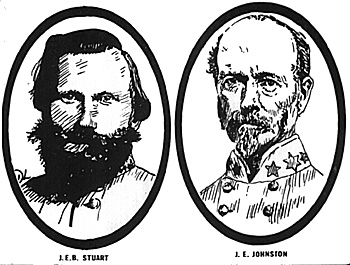 Though the Confederate Army had to be created practically from nothing, its senior officers were all drawn from Southerners who had resigned high ranks in the U.S. Army, and the President of the Confederate States had been Secretary of War in the Pierce administration. So, while there
were some deviations and innovations, the Confederate Army was patterned closely on that of the United States.
Though the Confederate Army had to be created practically from nothing, its senior officers were all drawn from Southerners who had resigned high ranks in the U.S. Army, and the President of the Confederate States had been Secretary of War in the Pierce administration. So, while there
were some deviations and innovations, the Confederate Army was patterned closely on that of the United States.
The infant Confederate government inherited both a crisis and a small armed force in Charleston Harbor, where South Carolina had been preparing to oust the Federal garrison of Fort Sumter as an assertion of independence from the United States.
On 1 March 1861 P. G. T. Beauregard, recently resigned Superintendent of West Point, and a native of Louisiana, was appointed Brigadier General of the Confederate Army (CSA) and sent to take charge at Charleston. After the Fort was surrendered, Beauregard became the first hero of the South, where he was thought to be another Napoleon in the making.
Overshadowed then, and still, by the doings in Charleston Harbor, Fort Pickens, in Pensacola Bay (Fla.), remained in Federal hands. Braxton Bragg, a native of the then unseceded North Carolina, but a resident of Louisiana and a hero of the Mexican War, was appointed Brigadier General, CSA, on 7 March 1861 and sent to command forces at Pensacola and the Gulf Coast from there to Mobile. On 22 March D. E. Twiggs was appointed to command of the District of Louisiana.
The firing on Fort Sumter forced those slave states that had not seceded to choose between supporting the Federal government's efforts to "suppress the rebellion" and joining the Confederacy. On 17 April Virginia, the most populated state in the South, voted to secede from the Union. Recruits were already collecting about the state, especially in the Shenandoah Valley, near the important arsenal at Harper's Ferry, scene of John Brown's Raid of two years before. On 28 April these troops, known as the Army of the Shenandoah, were put under command of T.J. Jackson, Colonel, CSA.
 P.G.T. BEAUREGARD
P.G.T. BEAUREGARD
On 21 May, 1861, Brig. Gen. M. L. Bonham (who had commanded South Carolina's forces at Charleston before Beauregard took over), took command of the troops on the "Alexandria Line," sometimes called the Department of Alexandria, just south of Washington, D.C. On the 23rd the Department of Norfolk was created under Brig. Gen. Benjamin Huger (pronounced "U-gee") for the defense of this coastal area.
On the 24th Brig. Gen. J. E. Johnston superceded Col. Jackson in command of the Army of the Shenandoah, and on the 26th the Department of the Peninsula was created under Col. John B. Magruder, with headquarters at Yorktown, for defense of the area between the York and James Rivers, east of Richmond, where Federal forces still held Fort Monroe. And so we see that the Confederates, like their Northern counterparts, began to organize their forces into geographical departments like those of the pre-war, peace-time Army.
On the 2nd of June, Bonham in the Alexandria Department was once again superceded by Beauregard, who dubbed his new force the Army of the Potomac. Forces in the valley of Kanawha River in Western Virginia (now West Virginia) were placed, on 6 June, under the command of Brig. Gen. Henry Wise, former governor of Virginia, and called the Army of the Kanawha. On 8 June, forces in the northwestern part of Virginia (now W. Va.), known as the Army of the Northwest, were put under the command of Brig. Gen. R. S. Garnett. This force opposed McClellan's advance into western Virginia and was defeated at Rich Mountain on 11 July. On the 13th Garnett was killed at Carrick's Ford while commanding his rearguard. He was succeeded temporarily by W. W. Loring on 20 July.
Also on 13 July Brig. Gen. Leonidas Polk, Episcopal Bishop of New Orleans, assumed command of Department Number Two, consisting of most of the Mississippi Valley and all of Arkansas east of the White River and Tennessee west of the Tennessee River. Its territory gradually expanded over the next several months. (Department Number One was a name applied to Twigg's District of Louisiana sometime in June or July.) A brigade under T. H. Holmes guarding the Potomac around Aquia Landing became known, around this time, as the Department of Fredericksburg.
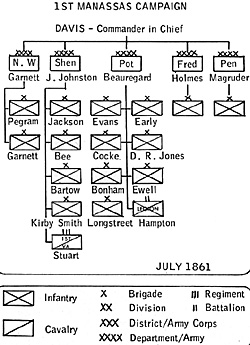 When the authorities in Richmond learned of the advance of McDowell's Union force toward Beauregard's forces near Manassas Junction, they ordered Holmes and Johnston (in the Shenandoah) to reinforce the hero of Fort Sumter. They arrived just in time to reverse a developing Federal victory in the battle known to the North as Bull Run and to Southerners as Manassas. Johnston, senior in grade to Beauregard, was in overall command, but as Beauregard was more familiar with the field he was allowed to direct the fighting.
When the authorities in Richmond learned of the advance of McDowell's Union force toward Beauregard's forces near Manassas Junction, they ordered Holmes and Johnston (in the Shenandoah) to reinforce the hero of Fort Sumter. They arrived just in time to reverse a developing Federal victory in the battle known to the North as Bull Run and to Southerners as Manassas. Johnston, senior in grade to Beauregard, was in overall command, but as Beauregard was more familiar with the field he was allowed to direct the fighting.
Logically enough, this victory did not cause the vast reorganization among the Confederates as defeat brought to the Federals. Holmes' and Johnston's forces remained as parts of the Confederate Army of the Potomac, however, with J. E. Johnston in command and Beauregard as his deputy.
On 11 August Wise was superceded in command of the Army of the Kanawha by Brig. Gen. John B. Floyd, another ex-governor of Virginia, Secretary of War in Buchanan's administration, and one of Wise's old political rivals. On 20 August the "defenses of North Carolina" were put under command of Brig. Gen. R. C. Gatlin and the next day the Department of South Carolina was established under Brig. Gen. Roswell Ripley.
On the 31st of August the new grade of "General" (or full General) was created in the Confederate Army and five officers promoted to it. First in seniority was Samuel Cooper, whose promotion was retroactive to 15 May 1861. Cooper, a Virginian, was the Adjutant and Inspector General of the Confederate Army, the same position he had held in the U.S. Army. His administrative experience was a great help to Davis in setting up the Confederate War Department.
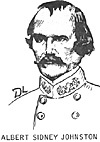 Next in seniority came Albert Sidney Johnston, presently enroute from California where he had been Commander of the Pacific Department in the U.S. Army. A West Point graduate, he rose from private to Brigadier General to Secretary of War in the Republic of Texas before rejoining the U.S. Army in 1849.
Next in seniority came Albert Sidney Johnston, presently enroute from California where he had been Commander of the Pacific Department in the U.S. Army. A West Point graduate, he rose from private to Brigadier General to Secretary of War in the Republic of Texas before rejoining the U.S. Army in 1849.
Next came Robert E. Lee, at that time in command of the forces in western Virginia. Then followed Joseph E. Johnston, commanding the Army of the Potomac, and finally, Beauregard, his deputy commander. Officers who resigned from the U.S. Army had been promised by the Confederate Government that they would hold the same relative rank in the Confederate Army as they had in the Federal. Cooper, the adjutant general, had been the senior colonel, A. S. Johnston a colonel since 1849, and Lee had only recently made colonel. Beauregard had only been a captain and owed his exalted rank to his performance at Fort Sumter and at Manassas. J. E. Johnston had been a lieutenant colonel until appointed quartermaster general with the rank of brigadier general shortly before the war. Davis counted J. E. Johnston to have been only a Lt. col. in the old army "because the quartermaster general was not considered in the line of promotion or eligible to active work in the field." In other words, the brigadier general's rank belonged to the position of quartermaster general, not to the man who filled it. Understandably, Johnston didn't see it that way. He considered himself to have been the senior officer to have joined the Confederate Army from the old, and he never forgave Davis for advancing three men over him.
It should be noted that this rank of full "General" is one that had never been used in the United States Army, and was not until after the war, when Grant was promoted to it as a reward for victory. It is now commonly known as "four-star general." However, neither side, at this time, had the "three-star" grade of lieutenant-general. The Confederates skipped over this grade and the U.S. Army only went up to major-general (two-star) until 1864, when Grant became the first officer to hold the rank of lieutenant general in the U.S. Army since George Washington.
On 4 September Polk advanced with forces from his Department 2 into Kentucky to establish a defensive position on the Mississippi at Columbus. This violated the neutrality Kentucky had proclaimed and which had been outwardly observed by both sides until now, though both had been recruiting troops within the state. A. S. Johnston was assigned to command of Department #2, which now included Kentucky, on 15 September, but would not arrive to take command for over a month. Meanwhile S. B. Buckner, Major General of Kentucky Militia threw in his lot (and troops) with the Confederacy. His forces, at Bowling Green, were known as the Central Division of Kentucky. Meanwhile, Brig. Gen. Zollicoffer advanced from Knoxville, Tennessee, through Cumberland Gap (where Kentucky, Tennessee, and Virginia meet), the gateway between central Kentucky and eastern Tennessee (an area of predominantly pro-Union sentiment). At Wild Cat Mountain, on 21 October, Zollicoffer was driven back to Cumberland Gap by Schoepf's 1st Brig. of Sherman's Union Department of the Cumberland, where Zollicoffer fortified.
On the 14th of October Bragg's command on the Gulf Coast was officially designated the Department of Alabama and West Florida, and on the 22nd his forces around Pensacola Bay were designated the Army of Pensacola. On the 18th, Twiggs was succeeded in command of Department by Maj. Gen. Mansfield Lovell. And on the 22nd of October J. E. Johnston's command was redesignated the Department of Northern Virginia, which was subdivided into three districts: the Aquia District, under Holmes, around Aquia Landing on the Potomac north of Fredericksburg; the District (and Army) of the Potomac, under Beauregard, at Manassas; and the Valley District, under Brig. Gen. T. J. Jackson (known as "Stonewall" since the Battle of Manassas), in the Shenandoah Valley.
On the 26th of October a new Department of Georgia was established under A. R. Lawton. Ten days later (5 November) this department and Ripley's Department of South Carolina were combined as the Department of South Carolina, Georgia and Florida. Robert E. Lee, who had been in West Virginia directing the operations of Floyd's Army of the Kanawha and Loring's Army of the Northwest, was assigned to the new command, taking Donelson's Brigade of Loring's command with him.
On 28 October, A. S. Johnston assumed command of the Western Department (# 2) at Bowling Green, Kentucky, where he commanded Buckner's division at Bowling Green, Polk's at Columbus, and Zollicoffer's Brigade at Cumberland Gap. In November he was reinforced at Bowling Green by a division of new troops under W. J. Hardee and by Floyd with his own and McCausland's brigades from the Army of the Kanawha, which was broken up--the other brigade, under Wise, going to Norfolk to reinforce Huger.
Meanwhile, Loring, with his Army of the Northwest (3 brigades) was sent to reinforce "Stonewall" Jackson's Valley District, but one other brigade, under H. R. Jackson, remained to guard the Allegheny passes at Monterey (Stonewall also had his old "Stonewall Brigade" and two brigades of Virginia militia). Two new brigades under Heth (pronounced Heath) and Marshall guarded the passes further south, at Lewisburg and Tazewell, respectively.
In November Zollicoffer advanced from Cumberland Gap about 70 miles northwest to the Cumberland River, crossed over and dug in nearBeechGrove. When George B. Crittenden arrived in Knoxville on 24 Novemberto assume command of the district he ordered Zollicoffer to withdraw to the south side of the Cumberland. In early January Crittenden arrived to take personal command and found Zollicoffer still north of the river and Union General Thomas advancing on his position. Crittenden attacked Thomas on 19 January 1862. Zollicoffer was killed and the Confederates badly beaten.
Some time in December 1861 a Department of Henrico was established under John H. Winder. This department encompassed Henrico County, Virginia, which at that time included the city of Richmond.
On 27 January Bragg organized part of his forces in the Department of Alabama and West Florida as the Army of Mobile, under J. M. Withers. On 29 January 1862, Maj. Gen. Earl Van Dorn was reassigned from J. E. Johnston's Army of the Potomac to command the Trans-Mississippi District of A. S. Johnston's Department 2. Also in this department, Brig. Gen. Lloyd Tilghman had accumulated a division-sized force at Forts Henry and Donelson, guarding the Tennessee and Cumberland Rivers, respectively, just south of the Tennessee-Kentucky line.
On 6 February Fort Henry was attacked by Foote's gunboats and Grant's forces from Cairo, Illinois, and Paducah, Kentucky. The fort was so low and the river so high that it was actually inundating the fort, so Tilghman sent his main force across country to Fort Donelson and, after a brief delaying action, surrendered himself and Fort Henry to the gunboats. Command of the forces at Fort Donelson devolved on Gideon Pillow. A. S. Johnston at Bowling Green was outflanked and cut off from Polk at Columbus. He decided to fall back to the Cumberland River at Nashville, and to protect his movement he sent Floyd and Buckner to reinforce Pillow. Buckner's and Pillow's troops were captured along with the fort on 16 February. Pillow himself escaped as did Floyd, who had been the senior officer present, and his brigade of Virginia troops, also escaping was a smal I cavalry force under Lt. Col. N. B. Forrest.
Only two days after the fallofFortHenry theConfederate War Department was already moving to provide A. S. Johnston with reinforcements. Beauregard, unhappy as J. E. Johnston's second in command, was on his way to help the other Johnston supervise the vast areas of the West, but brought no troops with him. But Bragg was ordered to send at least four regiments to Knoxville and Lowell in New Orleans was directed to send 5,000 of his best equipped men to Columbus, Kentucky. On 18 February Bragg was directed to withdraw his forces from Pensacola and Mobile and report to A. S. Johnston. Bragg did leave a remnant of the Army of Mobile in place but took about 10,000 men with him, and he remained in command of his department, but on 28 February he appointed Samuel Jones to take charge in his absence.
Also in February, W. W. Loring was removed from Stonewall Jackson's command (as the two didn't get along), and sent to supervise Marshall and Heth's activities in southwestern Virginia. His troops remained with Jackson, except H. R. Jackson's brigade at Monterey, now under E. Johnson and calling itself the Army of the Allegheny.
Crittenden having been arrested for his defeat in Kentucky (known as Logan's Crossroads, or Mill Springs) and becauseof the area's remoteness from A.S. Johnston's main command, a new Department of East Tennessee was established 25 February with E. Kirby Smith in command, though he didn't arrive at Knoxville until 9 March.
On 3 March 1862 Lee was succeeded in command of the Department of South Carolina, Georgia and Florida by Maj. Gen. J. C. Pemberton. Lee became President Davis' special military assistant and advisor, actually functioning pretty much as a chief of staff.
On 4 March 1862, Van Dorn organized forces from his Trans-Mississippi District and Price's Missouri State Guard as the Army of the West, which was defeated by Curtis at Pea Ridge, Arkansas, 7-8 March. On 5 March Beauregard organized Polk's forces from Columbus, and Bragg's reinforcements into the Army of the Mississippi. The force under A. S. Johnston's immediate command, known as the Army of Kentucky, joined forces with Beauregard's force at Corinth, Mississippi, on 24 March. On the 29th these forces were reorganized as the Army of Mississippi, under A. S. Johnston, with Beauregard again in a second-in-command position, and four division-sized forces, called corps (despite a Confederate law designating divisions as the largest units under an army), under Polk, Bragg, Hardee and Crittenden (soon replaced by Breckinridge).
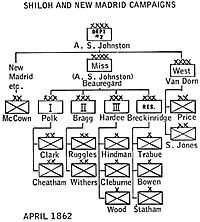 With this force Johnston attacked Grant at nearby Pittsburg Landing, in the battle better known as "Shiloh," on 6 April 1862. Johnston was mortally wounded on this field and succeeded by Beauregard. The next day Grant, with reinforcements, counterattacked and Beauregard withdrew to Corinth and entrenched, where he was soon reinforced by Van Dorn and the Army of the West (two divisions).
With this force Johnston attacked Grant at nearby Pittsburg Landing, in the battle better known as "Shiloh," on 6 April 1862. Johnston was mortally wounded on this field and succeeded by Beauregard. The next day Grant, with reinforcements, counterattacked and Beauregard withdrew to Corinth and entrenched, where he was soon reinforced by Van Dorn and the Army of the West (two divisions).
Meanwhile, Federal operations were also making vast organizational hanges necessary in Virginia. On 24 March Holmes was sent from the Aquia District of the Department of Northern Virginia to replace Gatlin in command of the Department of North Carolina. He was succeeded in the Aquia District by Maj. Gen. G. W. Smith. But as a result of McClellan's amphibious move to the Peninsula east of Richmond, Johnston (as A. S. Johnston died at Shiloh it no longer seems necessary to use the initials J. E. to identify this Johnston) was ordered to move there also. He took most of the forces of his Aquia and Potomac Districts, known as theArmyofthe Potomac, leaving Jackson to guard the Shenandoah, and one division under Maj. Gen. Ewell at Gordonsville. On 12 April, as Johnston's forces passed through Richmond enroute to the Peninsula, where Magruder was holding off McClellan with theatrical bluff, his Department of the Peninsula and Huger's Department of Norfolk were subordinated to Johnston's orders.
On 3 May Johnston retreated from his entrenchments on the Peninsula to avoid the blow McClellan had painstakingly prepared. His forces at this time, still normally referred to as the Army of the Potomac, but sometimes as the Army of the Peninsula, consisted of four large divisions of six brigades each (thus twice the size of Union divisions). These were styled the "Left Wing," under Maj. Gen. D. H. Hill; the "Reserve," Maj. Gen. G. W. Smith; the "Center," Maj. Gen. James Longstreet; and the "Right Wing" under Maj. Gen. J. B. Magruder. There was also a brigade of cavalry under Brig. Gen. J. E. B. Stuart. Johnston, as commander of the Department of Northern Virginia, still had nominal control of Jackson in the Valley, Ewell, now on the Blue Ridge, and three brigades plus assorted smaller units assembling south of Fredericksburg under Brig. Gen. J. R. Anderson.
Actually though, Jackson and Anderson often received their instructions from Lee, while Ewell and E. Johnston (guarding the Allegheny approaches from West Virginia, were subordinated to Jackson. Johnston had absorbed Magrudor's forces and Hugar's Department of Norfolk was still subject to his orders. On 9 May, the larter withdrew from Norfolk, however, to avoid being cut off, and retreated to Petersburg. His forces were thereafter referred to merely as Huger's Division. On 8 May, Loring's forces in the Allegehenies were designated the Department and Army of Southwest Virginia.
Since Van Dorn, commander of the Trans-Mississippi District of Beauregard's Department 2, remained on the east side of the Mississippi with his Army of the West, a command vacuum existed west of the Mississippi River. So, on 26 May 1862, the Trans-Mississippi Department was created under Maj. Gen. T. C. Hindman.
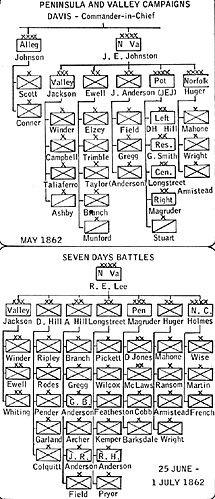 On 31 May Johnston attacked McClellan in the Battle of Seven Pines (or Fair Oaks). His forces were divided as follows: Magruder had six brigades divided into three informal divisions under himself, D. R. Jones, and McLaws; the "Left Wing" under G. W. Smith with his own division
of six brigades under Whiting and J. R. Anderson's 3 brigades front near Fredericksburg and Bratich's brigade of Ewell's Division from Gordonsville combined tinder a new Maj. Gern. A. P. Hill; and the "Right Wing" under Longstreet with his own division of six brigades, D. H. Hill's
with five, and Huger with three brigades from Petersburg. Johnston was severely wounded and the command passed temporarily to the senior Major General, G. W. Smith. However, on 1 June, President Davis assigned the command to General R. E. Lee, the only full General available (Cooper had no field experience at all but was strictly a staff officer, A. S. Johnston was dead, J. E. Johnston
wounded, and Beauregard in command of Department 2).
On 31 May Johnston attacked McClellan in the Battle of Seven Pines (or Fair Oaks). His forces were divided as follows: Magruder had six brigades divided into three informal divisions under himself, D. R. Jones, and McLaws; the "Left Wing" under G. W. Smith with his own division
of six brigades under Whiting and J. R. Anderson's 3 brigades front near Fredericksburg and Bratich's brigade of Ewell's Division from Gordonsville combined tinder a new Maj. Gern. A. P. Hill; and the "Right Wing" under Longstreet with his own division of six brigades, D. H. Hill's
with five, and Huger with three brigades from Petersburg. Johnston was severely wounded and the command passed temporarily to the senior Major General, G. W. Smith. However, on 1 June, President Davis assigned the command to General R. E. Lee, the only full General available (Cooper had no field experience at all but was strictly a staff officer, A. S. Johnston was dead, J. E. Johnston
wounded, and Beauregard in command of Department 2).
On 30 May, the day before Johnston's Battle of Seven Pines, Beauregard evacuated Corinth, Mississippi, to avoid having his army captured along with the city. On 17 June he placed himself on sick leave, entrusting the command to the next ranking officer, Bragg. On 27 June President Davis, not one of Beauregard's greatest fans, made the change permanent. Meanwhile the Department 2 he was inheriting had almost run out of territory. The enemy had conquered most of it and most of the rest had gone to form the Trans-Mississippi and East Tennessee Departments.
Also the Army of Mississippi had retreated clear into the neighboring Department # 1, which had recently lost New Orleans and southern Louisiana to the enemy. To further complicate matters, Bragg was still the commander of the Department of Alabama and West Florida. To clear all this up Department 2 and the Department of Alabama and West Florida were combined under Bragg. The part of the Department south of the 32nd parallel became the District of the Gulf under Brig. Gen. J. H. Forney.
On 20 June a new Department of Mississippi and East Louisiana was formed under Van Dorn (who took Breckiridge's Division with him) and on the 25th Louisiana west of the Mississippi was added to the Trans-Mississippi Department, and Department 1 ceases to exist.
Van Dorn was succeeded in command of the Army of the West by McCown, who had brought a division from the Department of E. Tennessee. However, on 2 July, Van Dorn's Department was subordinated to Bragg as the District of Mississippi and East Louisiana of Department # 2, and on the 3rd, Price became commander of the Army of the West.
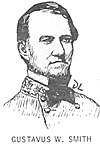 To return to the East, G. W. Smith left the Army of Northern Virginia (as Lee preferred to call it) due to illness on 2 June. Whiting continued in command of Smith's division (5 brigades) and Lee discontinued the informal "Wings" Johnston had employed (Confederate law still did not authorize actual Army Corps), except that Magruder continued to maintain his 6 brigades as 3 divisions under himself, D. R. Jones and McLaws. This arrangement was partially recognized by the promotion of McLaws to Major General. The other divisions were those of Longstreet (6 brigades), D. H. Hill (5 brigades), A. P. Hill (4 brigades) and Huger (4 brigades). On 11 June Whiting was sent, with Law's and Hood's brigades, to reinforce Jackson in the Shenandoah and his others brigades were transferred to A. P. Hill's division (one of which, Hampton's, was soon lost).
To return to the East, G. W. Smith left the Army of Northern Virginia (as Lee preferred to call it) due to illness on 2 June. Whiting continued in command of Smith's division (5 brigades) and Lee discontinued the informal "Wings" Johnston had employed (Confederate law still did not authorize actual Army Corps), except that Magruder continued to maintain his 6 brigades as 3 divisions under himself, D. R. Jones and McLaws. This arrangement was partially recognized by the promotion of McLaws to Major General. The other divisions were those of Longstreet (6 brigades), D. H. Hill (5 brigades), A. P. Hill (4 brigades) and Huger (4 brigades). On 11 June Whiting was sent, with Law's and Hood's brigades, to reinforce Jackson in the Shenandoah and his others brigades were transferred to A. P. Hill's division (one of which, Hampton's, was soon lost).
On 21 June 1862 Holmes' Department of North Carolina was expanded to include Virginia south of James River, and he personally commanded three brigades in the vicinity of Petersburg, since Huger had removed from there to join in the Battle of Seven Pines. Also, Lawton's brigade was sent From Holmes to reinforce Stonewall Jackson, arriving on 16 June, one day ahead of Whiting. However, Jackson's Valley campaign had served its purpose and on 26 June he arrived in the vicinity of Richmond to join in the attack on McClellan, known as the Seven Days' Battle. Besides Whiting, he had his own division (four brigades, including Lawton's) and Ewell's division (three brigades).
On 3 July, two days after the battle ended, Magruder was relieved of command. He had been slated for command of the Trans-Mississippi Department but due to charges and counter-charges regarding his part in the Seven Days, he was detained in Richmond for three months writing reports, etc.
Huger's performance was also unsatisfactory and he was made Inspector of Artillery and Ordnance and his division given to Maj. Gen. R. H. Anderson. Holmes was also disappointing in combat and he was succeeded in command of the Department of North Carolina on 17 July by D. H. Hill, a native of that state, who took his division with him south of James River. On 28 July Stuart's cavalry, grown to 7 regiments and 4 independent battalions, was constituted a division, with Stuart promoted to Major General and with Fitzhugh Lee (R. E.'s nephew) and Wade Hampton as Brigadiers.
Meanwhile, Jackson departed on 13 July for Gordonsville to deal with Pope's threat to the Virginia Central RR, taking his own and Ewell's divisions (less Taylor's Louisiana Brigade of Ewell). He was soon joined by the cavalry he had left in the Shenandoah, Robertson's "Laurel Brigade."
Longstreet was given informal command of most of the remaining infantry (his own division, A. P. Hill's, R. H. Anderson's and Magruder's old force, now divided between McLaws, with 4 brigades, and D. R. Jones, with two). Whiting's small division reported directly to Lee--perhaps because it had lately been part of Jackson's command, or because it had originally been part of G. W. Smith's force when the Army had been divided between Smith, Longstreet and Magruder, or perhaps just because Whiting seemed to need to be closely watched. A quarrel between Longstreet and A. P. Hill, and the need to reinforce Jackson, led to Hill being sent for that purpose on 27 July. With him went two Louisiana brigades formed from the one Ewell had left behind and Louisiana units from various ther commands. One joined Ewell's Division and the other Jackson's.
On 23 July Bragg began moving his Army of Mississippi from Tupelo via rail to Mobile and thence to Chattanooga in order to head off Buell's advance on the latter. He left Price with the Army of the West to defend northern Mississippi against Grant and Van Dorn to defend the Mississippi River "from advances upstream from New Orleans or down from Memphis or Helena, Arkansas." The latter sent Breckinridge with two divisions to retake Baton Rouge, which he attacked on 6 August, but was repulsed. Meanwhile, on 30 July, Holmes superceded Hindman in command of the Trans-Mississippi Department.
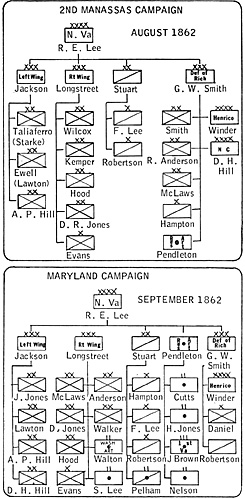 On 31 May Johnston On 10 August G. W. Smith was sufficiently recovered from his illness to return to duty and was given the division of 6 brigades which had recently been D. H. Hill's. On 13 August Longstreet departed Richmond to join Jackson on the Rapidan and Lee soon followed. G. W. Smith, as the senior Major General in the area was left in charge of the Richmond area with McLaws' division (4 brigades), R. H. Anderson's division (3 brigades) and D. H. Hill's Department of North Carolina, as well as his own division (formerly Hill's). Longstreet's force, styled the Right Wing (Jackson's the Left) consisted of his own division temporarily split between Brig. Gens. Wilcox and Kemper (3 brigades each), D. R. Jones' small division reinforced by a third brigade, under Drayton, from South Carolina, and Whiting's small division of 2 brigades (the rump of G. W. Smith's original division), now commanded by Hood.
On 31 May Johnston On 10 August G. W. Smith was sufficiently recovered from his illness to return to duty and was given the division of 6 brigades which had recently been D. H. Hill's. On 13 August Longstreet departed Richmond to join Jackson on the Rapidan and Lee soon followed. G. W. Smith, as the senior Major General in the area was left in charge of the Richmond area with McLaws' division (4 brigades), R. H. Anderson's division (3 brigades) and D. H. Hill's Department of North Carolina, as well as his own division (formerly Hill's). Longstreet's force, styled the Right Wing (Jackson's the Left) consisted of his own division temporarily split between Brig. Gens. Wilcox and Kemper (3 brigades each), D. R. Jones' small division reinforced by a third brigade, under Drayton, from South Carolina, and Whiting's small division of 2 brigades (the rump of G. W. Smith's original division), now commanded by Hood.
Another brigade, recently arrived from South Carolina under "Shanks" Evans was subordinate directly to Longstreet, probably because Evans was senior to any of Longstreet's division commanders and thus would automatically become commander of whichever one he might be assigned to. Lee's field force was rounded out by Stuart's cavalry division, rearranged by the transfer of the Laurel Brigade from Jackson and by leaving Hampton to serve with G. W. Smith. Lee's Army maintained this organization through the second Manassas Campaign.
On 14 August, the day after Longstreet headed north from Richmond, Kirby Smith moved out of Knoxville toward Kentucky with 2 cavalry brigades (Morgan and Scott) and two infantry divisions (Heth and Churchill)of his Department of East Tennessee and one small division, under Cleburne, lent to him by Bragg. A third East Tennessee division, under Stevenson, remained near Cumberland Gap to guard that area. On 25 August Smith designated his force the Army of Kentucky and McCown took temporary command of the Department of East Tennessee in his absence. On 28 August Bragg left Chattanooga to follow Smith, with his army divided into Right and Left Wings under Polk and Hardee, each with two infantry divisions and one cavalry brigade.
In preparation for the advance by Lee into Maryland, and since McClellan had been withdrawn from the vicinity of Richmond, more troops were sent from Washington to join the Army of Northern Virginia. Hampton's cavalry brigade rejoined Stuart, R. H. Anderson's infantry division (3 brigades); McLaws' division (4 brigades); D. H. Hill with most of his old division, recently Smith's (5 brigades); and a small division (2 brigades) of troops from the Department of North Carolina under Brig. Gen. Walker; also joining was the Reserve Artillery underBrig. Gen. Pendleton. Jackson's Left Wing remained unchanged except that J. R. Jones now commanded Jackson's old division, and Lawton commanded Ewell's. Longstreet's Right Wing received Walker's little division, McLaws' and R. H. Anderson. Then Longstreet's own division was discontinued with three brigades going to R. H. Anderson and three to D. R. Jones. Evans' brigade continued to report directly to Longstreet. D. H. Hill's division was assigned toJackson at first but after the latter moved against Harper's Ferry, Hill reported directly to Lee.
McLaws, R. H. Anderson, and Walker were temporarily detached from Longstreet for operations against Harper's Ferry but were returned in time for the Battle of Sharpsburg, 17 September 1862.
More ACW Armies
- American Civil War Part V: Confederate Departments and Armies: Manassas to Sharpsburg
American Civil War Part VII: Confederate Departments and Armies: Iuka to Meridian
American Civil War Part VIII: Union Departments, Armies, and Corps 1864-1865
American Civil War Part IX: Confederate Departments and Armies: Red River to Appomattox
Back to Table of Contents -- Panzerfaust #56
To Panzerfaust/Campaign List of Issues
To MagWeb Master Magazine List
© Copyright 1972 by Donald S. Lowry.
This article appears in MagWeb (Magazine Web) on the Internet World Wide Web.
Other military history articles and gaming articles are available at http://www.magweb.com